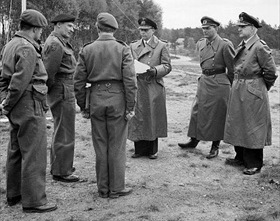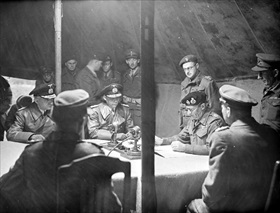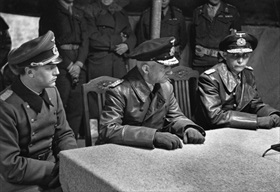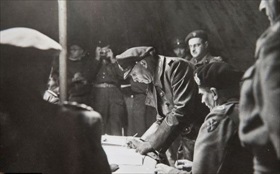FIRST OF THREE UNCONDITIONAL SURRENDERS OF GERMAN FORCES
Lueneburg Heath, Northern Germany • May 4, 1945
Lueneburg (German, Lüneburg), a district in Lower Saxony, Northern Germany, had been captured by elements of Field Marshal Bernard Law Montgomery’s 21st Army Group on April 18, 1945. Montgomery made his headquarters at Moellering Villa in the village of Haecklingen just south of Lueneburg. At midday, May 3, a carload of delegates from the German Wehrmacht (armed forces), headed by the supreme commander of the Kriegsmarine, Adm. Hans-George von Friedeburg, arrived at the Field Marshal’s tactical headquarters, a small tent on the Timeloberg hill, having been sent there by Grand Admiral Karl Doenitz. The grand admiral was Adolf Hitler’s successor (as Reich President and Supreme Commander of the German armed forces) after the Nazi leader had committed suicide on April 30 in his Fuehrerbunker deep under the Soviet-besieged Reich capital, Berlin. Doenitz was aware of the Allied occupation zones intended for Germany at the war’s conclusion. His plan was to draw out partial and local surrender negotiations in order to buy time for German troops, war and merchant ships, and refugees in the East (the Baltic States, Poland, East Prussia, and Eastern Germany) to escape the clutches of the advancing Soviet Army while trying to maintain a sanctuary on the west bank of the River Elbe, now Germany’s ever-shrinking eastern front.
Warned of the imminent arrival of the German emissaries—they had stopped briefly in British-occupied Hamburg—Montgomery in khaki trousers and a black beret, accompanied by 3 staff officers, gruffly welcomed the arrivals smartly dressed in greatcoats: the short, slightly built Friedeburg; 6 ft, 5 in/195 centimeter-tall Gen. Eberhard Kinzel; and Rear Admiral Gerhard Wagner. “Never heard of you,” Monty snapped at Friedeburg, who had introduced himself and members of his party. Montgomery quizzed his guests as to the reasons for their coming, the Germans riposting with their own questions regarding the scope of a German surrender should it be agreed to. Montgomery curtly shut down the back-and-forth and packed the Germans off to the visitors’ mess while he supervised preparations for the surrender table. He set a single chair at the head of 2 trestle tables pushed together and covered with army blankets—he wasn’t sharing the honored position with anyone. A pair of visitor chairs extended down both sides of the table; atop sat 2 microphones.
Montgomery wasted no time when the afternoon session began. All Wehrmacht units in Northwestern Europe must surrender unconditionally, he demanded, including those in Holland, mostly bypassed by Montgomery’s forces; Schleswig-Holstein, where Doenitz made his seat of government; and German-occupied Denmark. Units engaging the Soviet armed forces to the east were excluded from discussion. If they refused the terms, Montgomery threatened to press on with air and ground attacks against military and civilian targets in his warpath. Friedeburg was given 24 hours to convey Montgomery’s conditions to the Doenitz administration in Flensburg near the Danish border, which he did shortly before midnight. Doenitz and his military and civilian advisors agreed that more bloodshed was useless. The next morning, on this date, May 4, 1945, Friedeburg received full authority to accept Montgomery’s conditions. He and his 3 companions arrived back at Montgomery’s tent at 5 p.m. in pouring rain.
Klieg lights, photographers, war correspondents, and several of Montgomery’s staff welcomed the rain-soaked Germans into the tent. Montgomery read aloud the surrender terms in English (his visitors had a German copy) and said without a shred of niceties: “You will now sign.” A ceasefire came into effect at 8 o’clock the next morning, the same day Friedeburg left for Reims, France, on his second of 3 historic missions—attending another signing ceremony of unconditional surrender of Wehrmacht forces, this one at the headquarters of the Supreme Commander of Allied Forces in the West, Gen. Dwight D. Eisenhower, Montgomery’s military superior.
German Military Surrender to Field Marshal Bernard Montgomery’s 21st Army Group, Lueneburg Heath, May 4, 1945
 |  |
Left: Reich President and Grand Admiral Karl Doenitz’s plenipotentiaries under a flag of truce to Field Marshal Bernard Law Montgomery’s tactical headquarters at Lueneburg Heath, May 3, 1945. Facing Montgomery are Adm. Hans-Georg von Friedeburg (from left), next in naval seniority to Doenitz presenting his party’s credentials; Gen. Eberhard Kinzel, Chief of Staff to Field Marshal Ernst Busch, head of Army Group Northwest, which garrisoned German-occupied Netherlands; and Rear Adm. Gerhard Wagner, a member of Doenitz’s Flensburg staff. A TIME magazine journalist reported Montgomery’s surly reception of “his visitors.” But not 18 days earlier and an hour’s drive south of Monty’s headquarters, his soldiers had come across 73,000 corpses and half-dead figures sprawled across the grounds and in the barracks of Bergen-Belsen concentration camp. Perhaps Monty viewed Friedeburg and his fellow petitioners as sent from the devil himself.
![]()
Right: With the return of Doenitz’s delegates to Montgomery’s cramped 20‑sq‑ft/1.85‑sq‑m HQ tent on May 4, 1945 (Kinzel had stayed overnight), the British field marshal, in full uniform showing his rank and decorations, read the military surrender document out loud and into the microphones on the table. The English, not the German, version was the official surrender document. Admirals Wagner and Friedeburg face the camera on Montgomery’s right. Gen. Kinzel is to Montgomery’s left, back to camera.
 |  |
Left: The picture of anguish and glum, a tearful Adm. Friedeburg (right) stares into the camera. On the far left is 28-year-old Maj. Hans Jochen Friedel, staff officer to Gen. Kinzel. Between the two is Rear Adm. Gerhard Wagner. Both Wagner and Friedeburg committed suicide on May 23, 1945, when British forces arrested members of Doenitz’s cabinet along with some 5,000 officers and other ranks of the Wehrmacht in Flensburg, Doenitz’s headquarters near the Danish border.![]()
Right: Adm. Friedeburg signing the Instrument of Surrender of All German Armed Forces in Holland, Northwest Germany, and Denmark, Lueneburg Heath, May 4, 1945. Friedeburg was the only representative of the German High Command to be present at the signing of the German instruments of surrender in Lueneburg Heath on May 4, in Reims on May 7, and in Berlin on May 8, 1945. On the day he was taken prisoner on the orders of Gen. Eisenhower, along with other members of the Doenitz administration, Friedeburg told the Grand Admiral, “I don’t think I can stand the circus that is about to begin” (quoted in Turner, Karl Doenitz and the Last Days of the Third Reich, p. 247). Locking himself in a bathroom, Friedeburg killed himself.
Contemporary Newsreel Footage of the German Capitulation to Field Marshal Bernard Montgomery’s 21st Army Group, Lueneburg Heath, May 4, 1945
![]()

 History buffs, there is good news! The Daily Chronicles of World War II is now available as an ebook for $4.99 on Amazon.com. Containing a year’s worth of dated entries from this website, the ebook brings the story of this tumultuous era to life in a compelling, authoritative, and succinct manner. Featuring inventive navigation aids, the ebook enables readers to instantly move forward or backward by month and date to different dated entries. Simple and elegant! Click
History buffs, there is good news! The Daily Chronicles of World War II is now available as an ebook for $4.99 on Amazon.com. Containing a year’s worth of dated entries from this website, the ebook brings the story of this tumultuous era to life in a compelling, authoritative, and succinct manner. Featuring inventive navigation aids, the ebook enables readers to instantly move forward or backward by month and date to different dated entries. Simple and elegant! Click 











